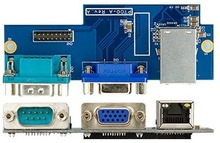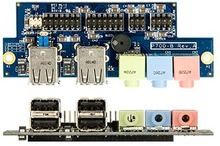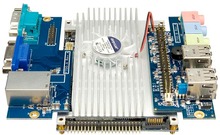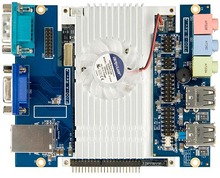Pico-ITX board bears twins
Jun 30, 2008 — by LinuxDevices Staff — from the LinuxDevices Archive — 22 views Via Technologies has announced a third motherboard using its tiny 3.9 x 2.8 inch pico-ITX format. Available with a 1GHz C7 or 500MHz Eden ULV processor, the P700 boasts an onboard DC-DC adapter, and comes with two daughterboards that add real-world I/O connectors.
Via Technologies has announced a third motherboard using its tiny 3.9 x 2.8 inch pico-ITX format. Available with a 1GHz C7 or 500MHz Eden ULV processor, the P700 boasts an onboard DC-DC adapter, and comes with two daughterboards that add real-world I/O connectors.
(Click for larger view of the tiny P700)
The Epia P700 is a follow-on to Via's PX10000G, the company's initial pico-ITX board that shipped in May 2007. Via's second pico-ITX effort was the PX5000EG, which moved to a 500MHz Eden ULV processor for passive cooling applications.

The P700, sans daughterboards
(Click to enlarge)
The new Epia P700 is available with the 1GHz Via C7 processor as the Via Epia P700-10L, or with the fanless 500MHz Eden ULV as the Epia P700-05LE. Both models include an integrated power adapter, enabling them to accept 12VDC power directly — and even power 5V SATA drives — without an external power daughterboard. Compared to the older pico-ITX products, other improvements include gigabit Ethernet, and bundled companion boards with real-world connectors.


The P700-A (l) and P700-B (r) daughterboards
(Click to enlarge)
The Epia P700 comes with P700-A and P700-B “companion boards” that fit atop the linear pin headers located at the left and right of the main board, as seen below. The P700-A provides an RJ45 connector for gigabit Ethernet, a VGA port, and a COM port, while P-700B sports four USB ports and three audio jacks. Other connectors on the Epia P700 include a 44-pin IDE connector, and a SATA connector.


The P700, with daughterboards
(Click to enlarge)
Securely mounted, the P700's daughterboards can effectively be considered part of the main board. However, they do approximately double its width (overall system dimensions were not cited by Via). Alternatively, for installations where a small footprint is more important than overall system height, the companion boards could be mounted below the main board, given suitable cabling and mounting brackets.
As mentioned, the Epia P700 is offered with a choice of CPUs, both supported by Via's VX700, a core-logic chip that integrates the company's VN800 northbridge and VT8237 southbridge functionality. Graphics capabilities include 2D/3D graphics acceleration, MPEG2 support, and dual monitor outputs. Meanwhile, a single SODIMM socket accommodates up to 1GB of DDR2 533 SDRAM memory.
Via lists the following key features and specifications for the Epia P700 board:
- Processor/chipset:
- Via Eden ULV 500 clocked at 500MHz or 1.0GHz Via C7
- Via VX700 Unified Digital Media IGP chipset
- Memory — DDR2 533MHz SODIMM socket for up to 1GB memory
- Display — integrated Via UniChrome Pro II 3D/2D AGP graphics with MPEG-2/4 and WMV9 decoding acceleration
- Networking — Via VT6122 gigabit Ethernet controller
- I/O:
- Pin connectors:
- 1 x LAN
- 1 x CRT/DVI
- 1 x COM
- 1 x CPU fan connector
- 1 x audio pin connector for line out, line in, mic in
- 4 x USB 2.0
- 1 x PS/2 keyboard/mouse
- 1 x LVDS
- 1 x LPC/SM Bus/GPIO
- 1 x LAN
- Real-world connectors (on companion boards):
- 1 x RJ45 gigabit Ethernet
- 1 x VGA
- 1 x COM
- 4 x USB 2.0
- 3 x 3.5mm audio (line out, line in, mic in)
- 1 x RJ45 gigabit Ethernet
- Pin connectors:
- Dimensions — 3.9 x 2.8 inches (main board)
- Operating temperature — 0 to 50 deg. C
- Dimensions — 3.9 x 2.8 inches (100 x 72mm)
- Power consumption — “under 13 watts”
Other recent developments in the pico-ITX world have included:
- The Small Form Factor SIG (SFF-SIG) adopted the format, with an eye to adding on its SUMIT (stackable unified module interconnect technology) interface
- Microsoft made pico-ITX systems part of its low-cost “Spark Your Imagination” program for students and hobbyists
- TechInsights gave away pico-ITX systems to attendees at the Embedded Systems Conference (ESC)
- Delock shipped a pico-ITX based DIN-rail PC
- Via offered a hobbyist-priced Artigo pico-ITX system with chassis
- Sharp and Tappin Technology launched high-style pico-ITX hobbyist systems
- Mini-ITX giant Logic Supply offered a heat-piped pico-ITX case
- Mini-ITX.com reviewed the PX10000G
Via Technologies did not reveal pricing or availability information for the Epia P700, but the board is available now. It is compatible with Linux, Windows CE, and Windows XP Embedded.
This article was originally published on LinuxDevices.com and has been donated to the open source community by QuinStreet Inc. Please visit LinuxToday.com for up-to-date news and articles about Linux and open source.